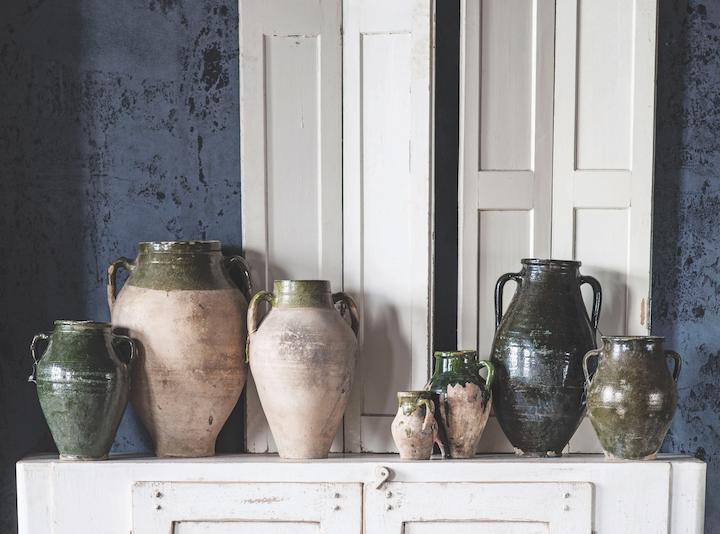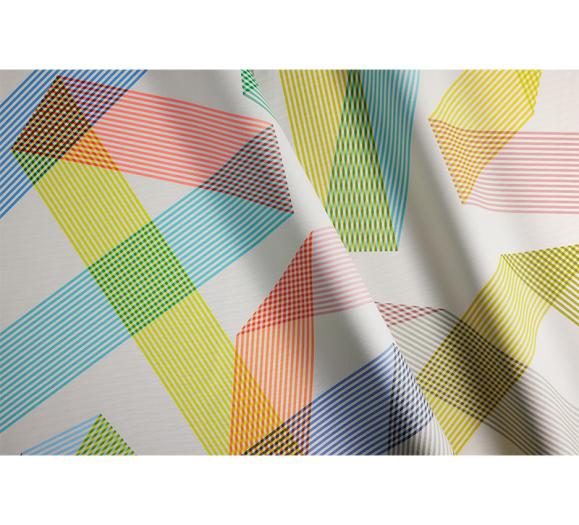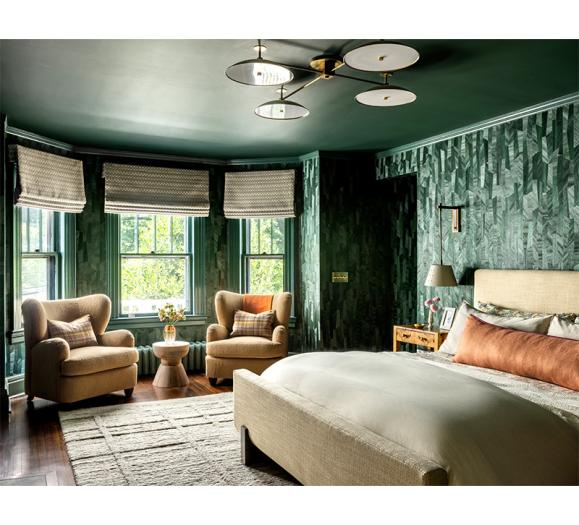We’re living in the Age of Experience. Consumers are looking for the next Instagrammable moment and are looking to show the world the things they’ve done and the things they have that make them unique. One-of-a-kind, vintage and antique home furnishings can help satisfy that desire, turning a home into a distinctive space unlike any other.
“Everybody wants to show they live these fabulous, amazing multicultural lives,” says Toma Clark Haines, Owner of The Antiques Diva & Co., an antiques touring and sourcing company that takes clients on private antiquing tours through Europe, Asia and America. “Everyone wants to show this wanderlust, this globally chic life that they’re living.”
Based in Italy, Clark Haines works with designers, retailers and even manufacturers to help them find unique pieces for their clients, stock their store with one-of-a-kind goods, and spice up their showrooms with accessories that complement their products. And sometimes her clients are just looking for inspiration. Whatever the goal, Clark Haines is passionate about helping clients find exactly what they don’t know they’re looking for.
One of the biggest mistakes Clark Haines sees clients make is coming into the sourcing process with an agenda. When an interior designer gives her measurements, she tells them to skip antiquing and go the custom route.
“That’s not why you buy antiques,” she says. “There are a million things you can have made for yourself. You can buy something new. You buy antiques because of the patina, because of that struck-by-lightning moment, because it’s so perfect you’re going to make it work. You really have to let the piece speak to you.”
For those who prefer to stay stateside, there are a number of vendors that offer one-of-a-kind items either exclusively or as a supplement to their manufactured pieces. Many companies have product sourcing teams whose job it is to find unique items that can either be sold as-is or repurposed and given a new life.
At Blue Ocean Traders, around half of their products are vintage, while the rest are newly manufactured.
“We really try to look ahead of the trend,” says Jason Mulvene, President and Owner of Blue Ocean Traders. “We will travel anywhere to find the next great category. We also look to find one-of-a-kind items that we can offer at consistent value. We cover a big range of unique items, from minerals from Brazil to French and Swedish antiques to petrified wood tabletops from Indonesia. But our goal is always to find long-term sourcing partners that can bring us consistency with our one-of-a-kind sourcing.”
Creative Co-op has a selection of found objects on offer that includes furniture, lighting fixtures, containers and ceramics.
“We look for pieces that resonate with us and will relate to our retailers,” says Tamra Bryant, Senior Vice President of Product for Creative Co-op. “We look for great history and a unique story, whether it is a decorative or functional piece.”
Attention to Detail
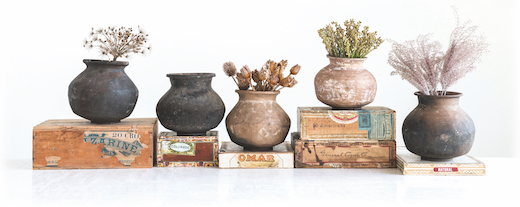
The story can be a unique selling point for retailers to convey to their customers. The product’s age, materials, craftsmanship and country of origin all offer opportunities for retailers to connect with their customers through storytelling. There are other factors to consider, as well.
“First and foremost we want all of our one-of-a-kind items to have soul,” Mulvene says. “We look for things that will be in style today and 20 years from now. Quality and value can be found in single items that just cannot be reproduced on a mass scale.”
Quality and value are key for everyone sourcing these products. Clark Haines says with antiques, there are a few characteristics to be aware of. The first is attention to detail.
“Every detail matters,” she says. “And with antiques, how you tell quality is often you see carving in places that no one’s really looking. You see a chair and they’ve carved a little flower in the front of the dining chair. No one’s looking at that. It’s under the table, it’s under your legs. But in the past, every detail was considered in a way that today I don’t think is often considered.” Look at the furniture from every angle, she says, and note whether it looks as good from the sides and back as it does the front.
Another way to spot quality antique furniture: Pick it up.
“If [antique dealers] are not selling entirely authentic materials, you can freak them out pretty quickly by walking over and picking up one chair,” Clark Haines says. “Now the way we mass produce furniture, the wood isn’t as mature as it was then. The wood is lighter. A more mature wood is going to weigh more than a tree that’s been grown in three years and chopped down. It’s just heavier, it’s denser.”
Value and price are a little trickier. Prices of found and antique objects depend on a number of factors, including country of origin, materials, age and product type. Wholesalers and retailers then set their own prices accordingly.
“We try to make sure that there is value for our retailers in everything that we do,” Mulvene says. “Although some price levels may not be for every market, we do work to be sure that we offer the best prices for a given item.”
Relationships are also important in the sourcing world and can be key for securing reasonable pricing.
“The price point sold at is largely dependent upon the person who’s selling it,” Clark Haines says. “Relationships are truthfully how you’re getting the best prices when it comes to something like this. Not just antiques, whether it’s vintage, handmade goods or artisan items, price becomes very subjective when there’s nothing to compare it to.” Working with trusted suppliers or a company like The Antiques Diva that already has these relationships can be beneficial when looking for a good deal.
Bringing Them Home
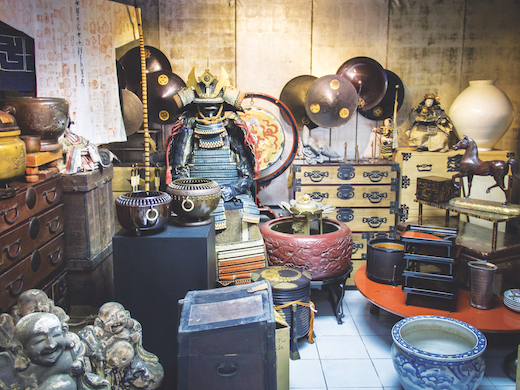
How do these products get from their countries of origin to a store’s shelves, a client’s home or a manufacturer’s showroom? For Clark Haines’ clients, shipping can be the biggest barrier to entry.
“The number one mistake is they just simply don’t buy because they’re afraid to get it home,” she says. “And the reality is, you can always get it home. If you see something, you love it, you tell the vendor, ‘I want this piece. How do I get it home?’ Trust me, if the vendor wants to sell it to you enough, they’re going to come up with a solution.” Otherwise, “Google is your friend,” she says. For smaller items, you can use a local post office or carry items on the plane home.
Blue Ocean Traders works with a network of brokers to consolidate the found goods and move them through customs. Once they’ve arrived, the team inspects them and prepares them for sale.
Creative Co-op has a similar process.
“The process from discovery to store shelves is different for every item and every country the item originated in,” Bryant says. “Once the original items are sourced, then they are cleaned, fixed and modified depending on the item before they become a new offering in our selection. We normally always place a natural wax on the items as well to enhance the beautiful aging of the stones.”
Found items offer sustainability benefits, as they can often be repurposed into new items, giving them new life and reducing waste. Creative Co-op’s vintage brick moulds, for example can stand alone as storage containers, but the company has also devised a number of ways to configure them into furniture and other functional pieces.
“The brick moulds no longer serve their original purpose, but we have been able to give them new life in unique cabinets, shelves, bar height tables, side boards, and even thread and spool organizers,” Bryant says. “The pieces are beautiful, but they are also unique, sustainable design and tell their own story, which adds character and interest to any space they find a home in.”
Standing Out
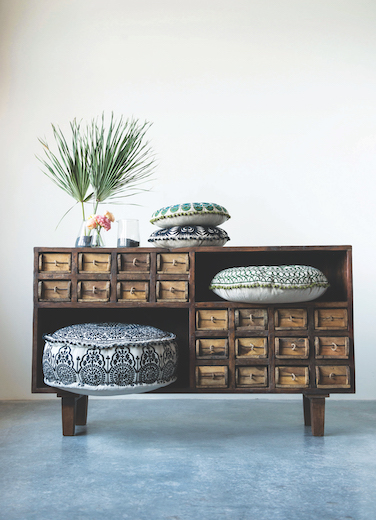
One-of-a-kind pieces offer an elevated level of uniqueness, giving retailers a leg up over the competition.
“Nothing beats the face to face experience of buying one-of-a-kind items in a store,” Mulvene says. “On top of that, everyone wants some ‘wow’ factor, originality and excitement that only comes from unique pieces. … With unique items no one can say, ‘It’s cheaper online.’”
In today’s Instagram age, this ‘wow’ factor can help draw customers in for that social media moment and keep them there to shop around.
“Antiques, vintage, one-of-a-kind, handmade artisan goods have the opportunity to give retailers an experience in their stores,” Clark Haines says. “Think theatrically, think in terms of staging ‘wow’ pieces. That’s where I think one-of-a-kinds and antiques and vintage really offer an opportunity to be that ‘wow’ moment that pulls someone in.” Sometimes the piece that brings them will never be the piece they buy, but it will get them into your store.
“The reality is, antiques and one-of-a-kind are never going to compete with contemporary furniture,” Clark Haines says. “It’s like apples and oranges.”
She advises that these pieces should complement your main offerings. If you specialize in furniture, for instance, add some vintage lamps or ceramics for a pop of color. For lighting retailers, look for vintage art or furniture. Whatever you sell, one-of-a-kind items can help enhance it.
“Don’t think of this as something that competes with your main product,” she says. “Think of this as something that’s a conversation starter, that’s offering more of an experience for your client, that’s offering a story for your client, a story for your buyer, and that’s going to help you sell that object that’s really your bread and butter.”



